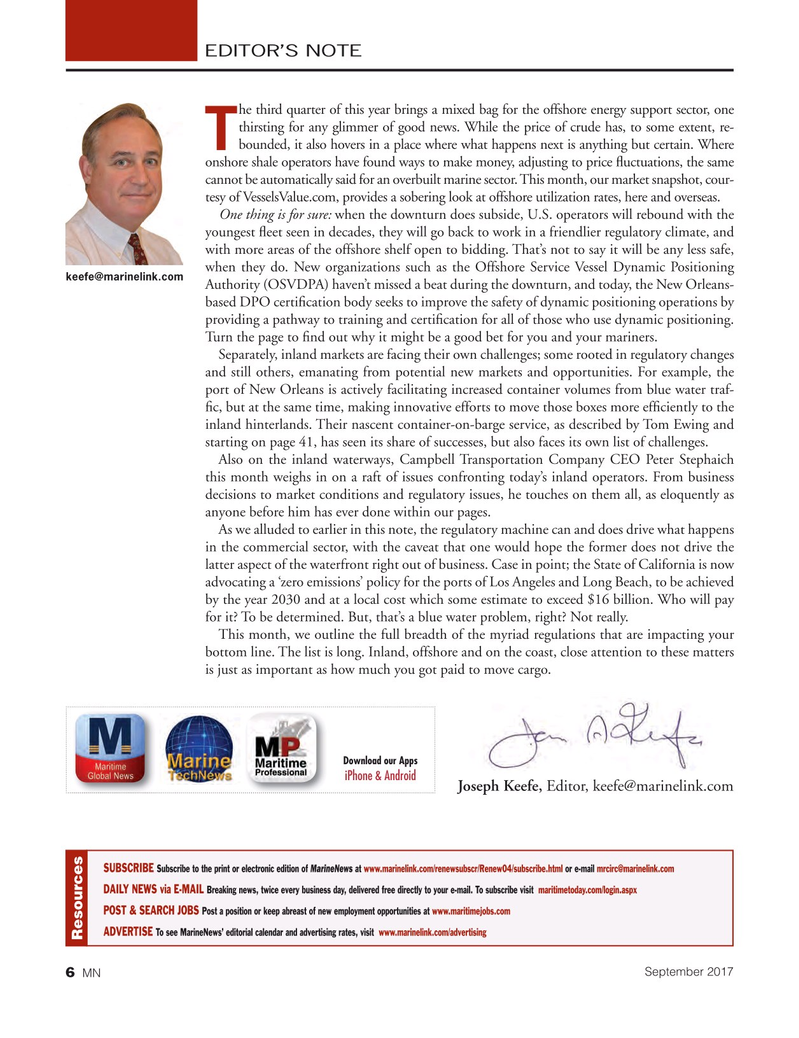
Page 6: of Marine News Magazine (September 2017)
Offshore Annual
Read this page in Pdf, Flash or Html5 edition of September 2017 Marine News Magazine
EDITOR’S NOTE he third quarter of this year brings a mixed bag for the offshore energy support sector, one thirsting for any glimmer of good news. While the price of crude has, to some extent, re- bounded, it also hovers in a place where what happens next is anything but certain. Where
T onshore shale operators have found ways to make money, adjusting to price ? uctuations, the same cannot be automatically said for an overbuilt marine sector. This month, our market snapshot, cour- tesy of VesselsValue.com, provides a sobering look at offshore utilization rates, here and overseas.
One thing is for sure: when the downturn does subside, U.S. operators will rebound with the youngest ? eet seen in decades, they will go back to work in a friendlier regulatory climate, and with more areas of the offshore shelf open to bidding. That’s not to say it will be any less safe, when they do. New organizations such as the Offshore Service Vessel Dynamic Positioning [email protected]
Authority (OSVDPA) haven’t missed a beat during the downturn, and today, the New Orleans- based DPO certi? cation body seeks to improve the safety of dynamic positioning operations by providing a pathway to training and certi? cation for all of those who use dynamic positioning.
Turn the page to ? nd out why it might be a good bet for you and your mariners.
Separately, inland markets are facing their own challenges; some rooted in regulatory changes and still others, emanating from potential new markets and opportunities. For example, the port of New Orleans is actively facilitating increased container volumes from blue water traf- ? c, but at the same time, making innovative efforts to move those boxes more ef? ciently to the inland hinterlands. Their nascent container-on-barge service, as described by Tom Ewing and starting on page 41, has seen its share of successes, but also faces its own list of challenges.
Also on the inland waterways, Campbell Transportation Company CEO Peter Stephaich this month weighs in on a raft of issues confronting today’s inland operators. From business decisions to market conditions and regulatory issues, he touches on them all, as eloquently as anyone before him has ever done within our pages.
As we alluded to earlier in this note, the regulatory machine can and does drive what happens in the commercial sector, with the caveat that one would hope the former does not drive the latter aspect of the waterfront right out of business. Case in point; the State of California is now advocating a ‘zero emissions’ policy for the ports of Los Angeles and Long Beach, to be achieved by the year 2030 and at a local cost which some estimate to exceed $16 billion. Who will pay for it? To be determined. But, that’s a blue water problem, right? Not really.
This month, we outline the full breadth of the myriad regulations that are impacting your bottom line. The list is long. Inland, offshore and on the coast, close attention to these matters is just as important as how much you got paid to move cargo.
Download our Apps iPhone & Android
Joseph Keefe, Editor, [email protected]
SUBSCRIBE Subscribe to the print or electronic edition of at www.marinelink.com/renewsubscr/Renew04/subscribe.html or e-mail [email protected]
DAILY NEWS via E-MAIL Breaking news, twice every business day, delivered free directly to your e-mail. To subscribe visit maritimetoday.com/login.aspx
POST & SEARCH JOBS Post a position or keep abreast of new employment opportunities at www.maritimejobs.com
ADVERTISE To see MarineNews’ editorial calendar and advertising rates, visit www.marinelink.com/advertising
Resources
September 2017 6 MN

 5
5

 7
7
